Brand Management Report: Strategies for Brand Building and Management
VerifiedAdded on 2021/01/01
|24
|6964
|465
Report
AI Summary
This report provides a comprehensive analysis of brand management, focusing on building and managing brand equity. It examines the key components of a successful brand strategy, including brand positioning, customer satisfaction, and brand loyalty. The report uses Optimum Impression Ltd., an advertising organization, as a case study to illustrate how brand equity can be managed through various strategies, including Keller's Customer-Based Brand Equity (CBBE) model. It also covers brand extension strategies like line extension, product development, and geographic extension. The report further evaluates techniques for managing and measuring brand awareness, emphasizing the importance of customer engagement and brand revitalization. Challenges faced by the organization, such as technological and survival crises, are also discussed, along with the importance of branding in marketing and its impact on a business's recognition, strategic advantage, and customer relationships. The report concludes by highlighting the effectiveness of branding as a marketing tool.
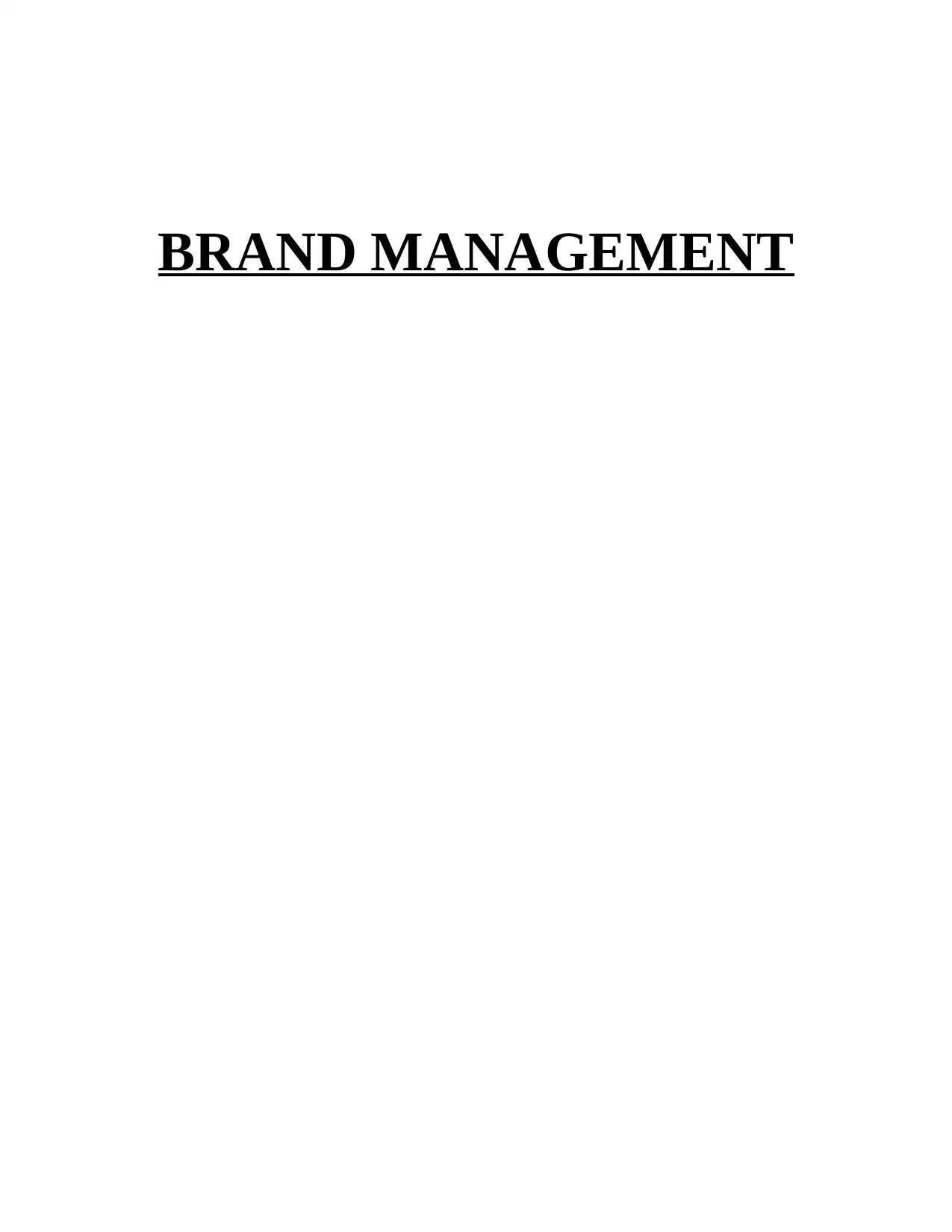
BRAND MANAGEMENT
Paraphrase This Document
Need a fresh take? Get an instant paraphrase of this document with our AI Paraphraser
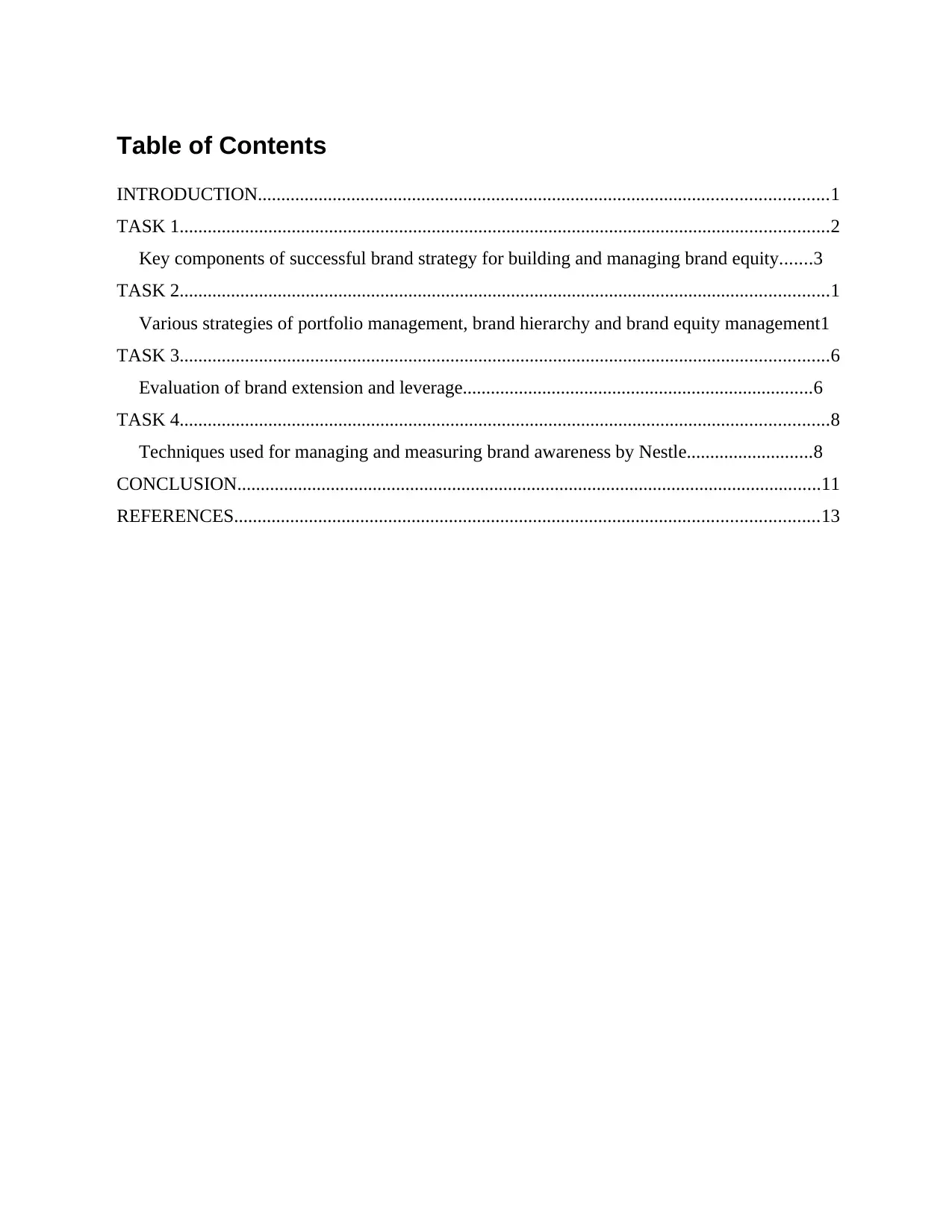
Table of Contents
INTRODUCTION..........................................................................................................................1
TASK 1...........................................................................................................................................2
Key components of successful brand strategy for building and managing brand equity.......3
TASK 2...........................................................................................................................................1
Various strategies of portfolio management, brand hierarchy and brand equity management1
TASK 3...........................................................................................................................................6
Evaluation of brand extension and leverage...........................................................................6
TASK 4...........................................................................................................................................8
Techniques used for managing and measuring brand awareness by Nestle...........................8
CONCLUSION.............................................................................................................................11
REFERENCES.............................................................................................................................13
INTRODUCTION..........................................................................................................................1
TASK 1...........................................................................................................................................2
Key components of successful brand strategy for building and managing brand equity.......3
TASK 2...........................................................................................................................................1
Various strategies of portfolio management, brand hierarchy and brand equity management1
TASK 3...........................................................................................................................................6
Evaluation of brand extension and leverage...........................................................................6
TASK 4...........................................................................................................................................8
Techniques used for managing and measuring brand awareness by Nestle...........................8
CONCLUSION.............................................................................................................................11
REFERENCES.............................................................................................................................13
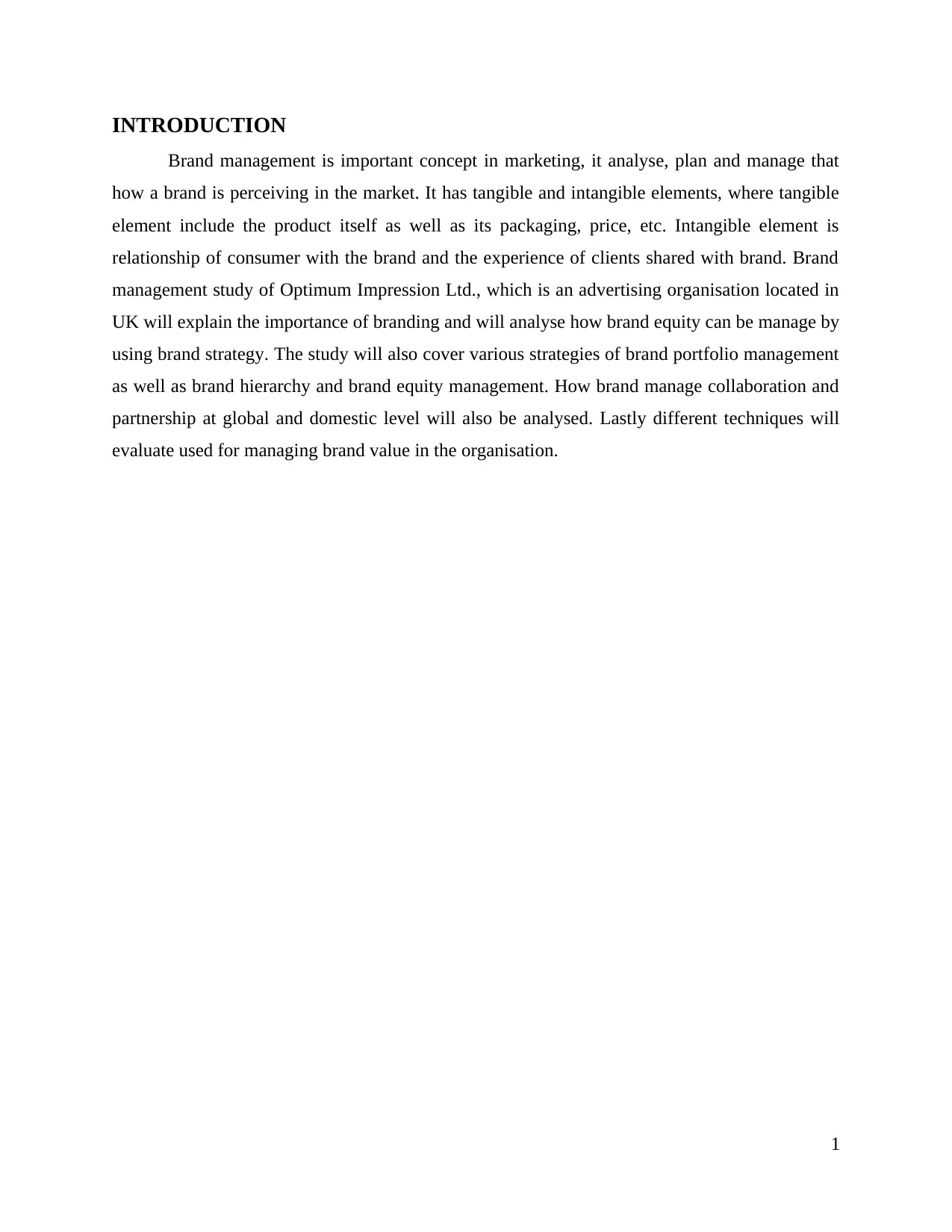
INTRODUCTION
Brand management is important concept in marketing, it analyse, plan and manage that
how a brand is perceiving in the market. It has tangible and intangible elements, where tangible
element include the product itself as well as its packaging, price, etc. Intangible element is
relationship of consumer with the brand and the experience of clients shared with brand. Brand
management study of Optimum Impression Ltd., which is an advertising organisation located in
UK will explain the importance of branding and will analyse how brand equity can be manage by
using brand strategy. The study will also cover various strategies of brand portfolio management
as well as brand hierarchy and brand equity management. How brand manage collaboration and
partnership at global and domestic level will also be analysed. Lastly different techniques will
evaluate used for managing brand value in the organisation.
1
Brand management is important concept in marketing, it analyse, plan and manage that
how a brand is perceiving in the market. It has tangible and intangible elements, where tangible
element include the product itself as well as its packaging, price, etc. Intangible element is
relationship of consumer with the brand and the experience of clients shared with brand. Brand
management study of Optimum Impression Ltd., which is an advertising organisation located in
UK will explain the importance of branding and will analyse how brand equity can be manage by
using brand strategy. The study will also cover various strategies of brand portfolio management
as well as brand hierarchy and brand equity management. How brand manage collaboration and
partnership at global and domestic level will also be analysed. Lastly different techniques will
evaluate used for managing brand value in the organisation.
1
⊘ This is a preview!⊘
Do you want full access?
Subscribe today to unlock all pages.

Trusted by 1+ million students worldwide
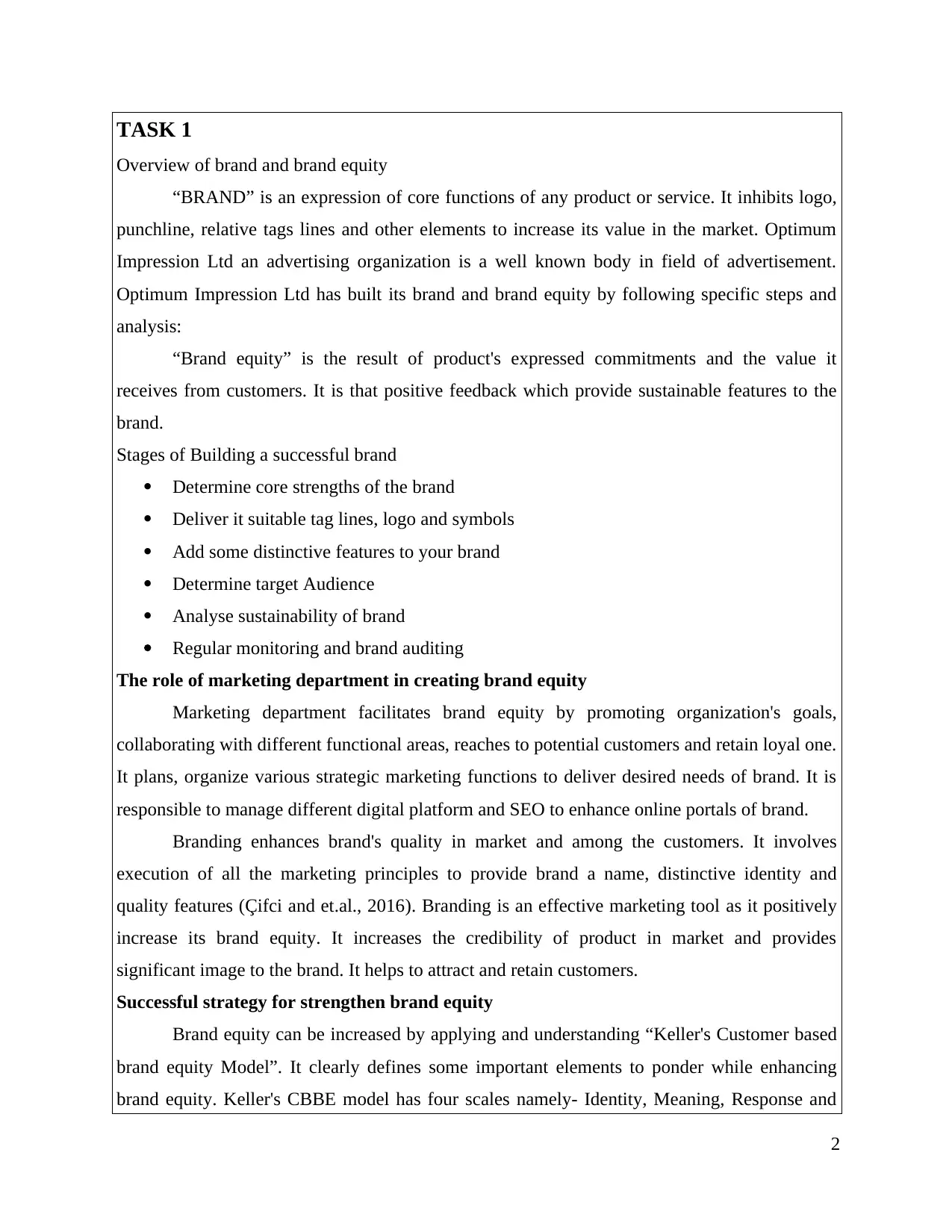
TASK 1
Overview of brand and brand equity
“BRAND” is an expression of core functions of any product or service. It inhibits logo,
punchline, relative tags lines and other elements to increase its value in the market. Optimum
Impression Ltd an advertising organization is a well known body in field of advertisement.
Optimum Impression Ltd has built its brand and brand equity by following specific steps and
analysis:
“Brand equity” is the result of product's expressed commitments and the value it
receives from customers. It is that positive feedback which provide sustainable features to the
brand.
Stages of Building a successful brand
Determine core strengths of the brand
Deliver it suitable tag lines, logo and symbols
Add some distinctive features to your brand
Determine target Audience
Analyse sustainability of brand
Regular monitoring and brand auditing
The role of marketing department in creating brand equity
Marketing department facilitates brand equity by promoting organization's goals,
collaborating with different functional areas, reaches to potential customers and retain loyal one.
It plans, organize various strategic marketing functions to deliver desired needs of brand. It is
responsible to manage different digital platform and SEO to enhance online portals of brand.
Branding enhances brand's quality in market and among the customers. It involves
execution of all the marketing principles to provide brand a name, distinctive identity and
quality features (Çifci and et.al., 2016). Branding is an effective marketing tool as it positively
increase its brand equity. It increases the credibility of product in market and provides
significant image to the brand. It helps to attract and retain customers.
Successful strategy for strengthen brand equity
Brand equity can be increased by applying and understanding “Keller's Customer based
brand equity Model”. It clearly defines some important elements to ponder while enhancing
brand equity. Keller's CBBE model has four scales namely- Identity, Meaning, Response and
2
Overview of brand and brand equity
“BRAND” is an expression of core functions of any product or service. It inhibits logo,
punchline, relative tags lines and other elements to increase its value in the market. Optimum
Impression Ltd an advertising organization is a well known body in field of advertisement.
Optimum Impression Ltd has built its brand and brand equity by following specific steps and
analysis:
“Brand equity” is the result of product's expressed commitments and the value it
receives from customers. It is that positive feedback which provide sustainable features to the
brand.
Stages of Building a successful brand
Determine core strengths of the brand
Deliver it suitable tag lines, logo and symbols
Add some distinctive features to your brand
Determine target Audience
Analyse sustainability of brand
Regular monitoring and brand auditing
The role of marketing department in creating brand equity
Marketing department facilitates brand equity by promoting organization's goals,
collaborating with different functional areas, reaches to potential customers and retain loyal one.
It plans, organize various strategic marketing functions to deliver desired needs of brand. It is
responsible to manage different digital platform and SEO to enhance online portals of brand.
Branding enhances brand's quality in market and among the customers. It involves
execution of all the marketing principles to provide brand a name, distinctive identity and
quality features (Çifci and et.al., 2016). Branding is an effective marketing tool as it positively
increase its brand equity. It increases the credibility of product in market and provides
significant image to the brand. It helps to attract and retain customers.
Successful strategy for strengthen brand equity
Brand equity can be increased by applying and understanding “Keller's Customer based
brand equity Model”. It clearly defines some important elements to ponder while enhancing
brand equity. Keller's CBBE model has four scales namely- Identity, Meaning, Response and
2
Paraphrase This Document
Need a fresh take? Get an instant paraphrase of this document with our AI Paraphraser
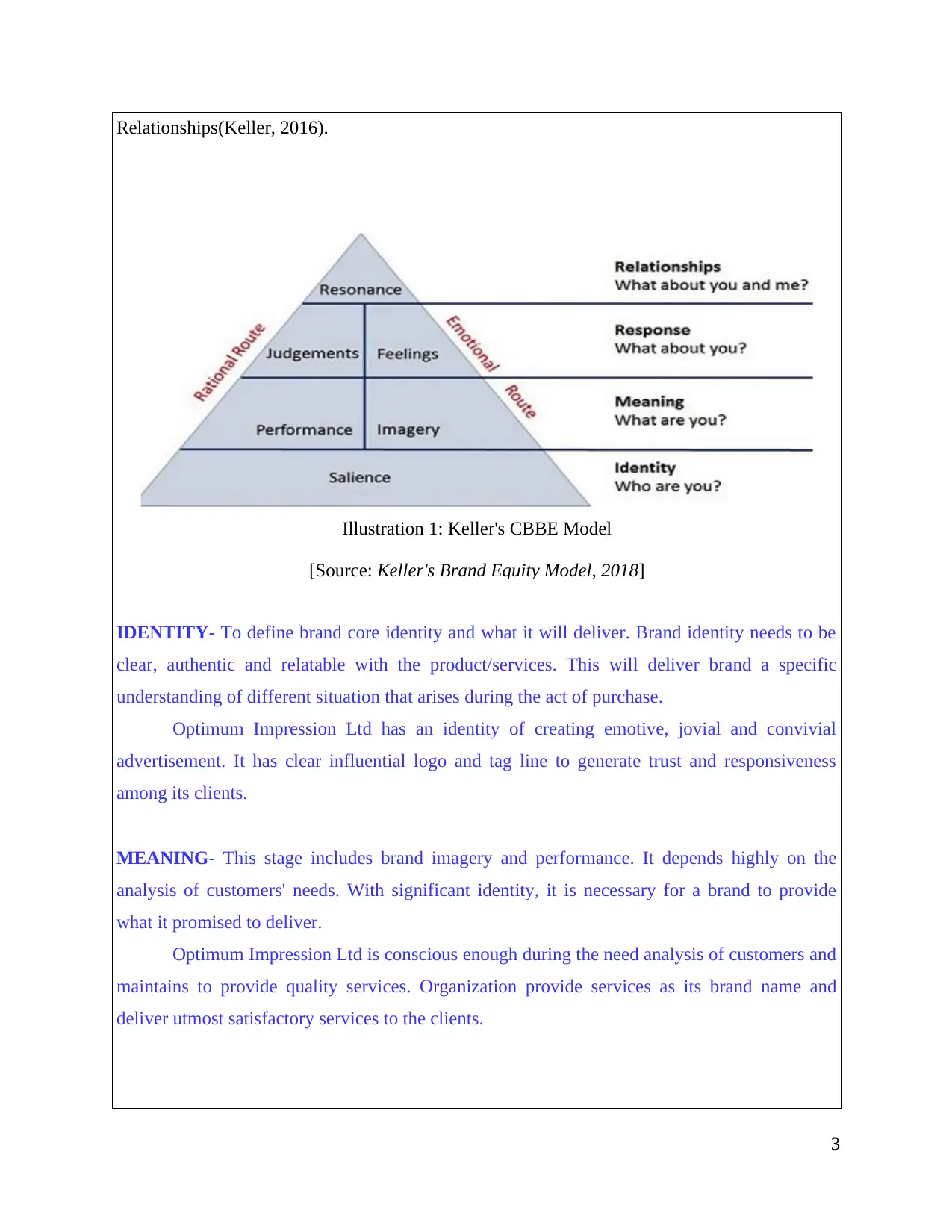
Relationships(Keller, 2016).
IDENTITY- To define brand core identity and what it will deliver. Brand identity needs to be
clear, authentic and relatable with the product/services. This will deliver brand a specific
understanding of different situation that arises during the act of purchase.
Optimum Impression Ltd has an identity of creating emotive, jovial and convivial
advertisement. It has clear influential logo and tag line to generate trust and responsiveness
among its clients.
MEANING- This stage includes brand imagery and performance. It depends highly on the
analysis of customers' needs. With significant identity, it is necessary for a brand to provide
what it promised to deliver.
Optimum Impression Ltd is conscious enough during the need analysis of customers and
maintains to provide quality services. Organization provide services as its brand name and
deliver utmost satisfactory services to the clients.
3
Illustration 1: Keller's CBBE Model
[Source: Keller's Brand Equity Model, 2018]
IDENTITY- To define brand core identity and what it will deliver. Brand identity needs to be
clear, authentic and relatable with the product/services. This will deliver brand a specific
understanding of different situation that arises during the act of purchase.
Optimum Impression Ltd has an identity of creating emotive, jovial and convivial
advertisement. It has clear influential logo and tag line to generate trust and responsiveness
among its clients.
MEANING- This stage includes brand imagery and performance. It depends highly on the
analysis of customers' needs. With significant identity, it is necessary for a brand to provide
what it promised to deliver.
Optimum Impression Ltd is conscious enough during the need analysis of customers and
maintains to provide quality services. Organization provide services as its brand name and
deliver utmost satisfactory services to the clients.
3
Illustration 1: Keller's CBBE Model
[Source: Keller's Brand Equity Model, 2018]

RESPONSE- Responses of customers for brand is the most considerable element that need to
be analysed by every manager(Keller, 2016). These are reciprocation of what we presented and
what they expected. By responses brand can be enhanced and evaluated.
Engaging and active participations in digital feedback campaign has provided Optimum
Impressions a great tool to evaluate its clients and customers.
RELATIONSHIPS- Relationships within the organizations and external bodies influence
organization's image, credibility of services provided by employees increases. Hence, managers
with related organizational staff must enhance employee engagement and customer engagement
measures(Keller, 2016).
Optimum Impression Ltd. has successfully generated brand equity by targeting touch points of
the customers. The customer engagement policies, commitments and quality services raises its
standards among its customers. Along with this, the organization can have long term impact on
its customers by CONSISTENCY, LOYALTY, QUALITY and hence establishing strong bond
with the customers.
The application of mentioned model is highly fruitful in determining the needs of the customers
and brand as well.
Advantages of model are:
It provides sufficient guidelines to organizations for improve communication.
It sensitizes the company regarding different customers' needs. It focuses on each and every possible aspect related to customers' buying behaviour.
Disadvantages of model are:
It also consists of some elements that are not adequately necessary for industrial
marketing.
It does not suggest any solutions with respect to the responses of the customers.
Benefits of branding for a business
Branding is utmost important process for every business. It has variant of advantages.
For every business branding creates a channel of productivity. For instance, Optimum
impression Ltd. may undergo for the assessments of its services and customers and
conduct branding accordingly.
4
be analysed by every manager(Keller, 2016). These are reciprocation of what we presented and
what they expected. By responses brand can be enhanced and evaluated.
Engaging and active participations in digital feedback campaign has provided Optimum
Impressions a great tool to evaluate its clients and customers.
RELATIONSHIPS- Relationships within the organizations and external bodies influence
organization's image, credibility of services provided by employees increases. Hence, managers
with related organizational staff must enhance employee engagement and customer engagement
measures(Keller, 2016).
Optimum Impression Ltd. has successfully generated brand equity by targeting touch points of
the customers. The customer engagement policies, commitments and quality services raises its
standards among its customers. Along with this, the organization can have long term impact on
its customers by CONSISTENCY, LOYALTY, QUALITY and hence establishing strong bond
with the customers.
The application of mentioned model is highly fruitful in determining the needs of the customers
and brand as well.
Advantages of model are:
It provides sufficient guidelines to organizations for improve communication.
It sensitizes the company regarding different customers' needs. It focuses on each and every possible aspect related to customers' buying behaviour.
Disadvantages of model are:
It also consists of some elements that are not adequately necessary for industrial
marketing.
It does not suggest any solutions with respect to the responses of the customers.
Benefits of branding for a business
Branding is utmost important process for every business. It has variant of advantages.
For every business branding creates a channel of productivity. For instance, Optimum
impression Ltd. may undergo for the assessments of its services and customers and
conduct branding accordingly.
4
⊘ This is a preview!⊘
Do you want full access?
Subscribe today to unlock all pages.

Trusted by 1+ million students worldwide
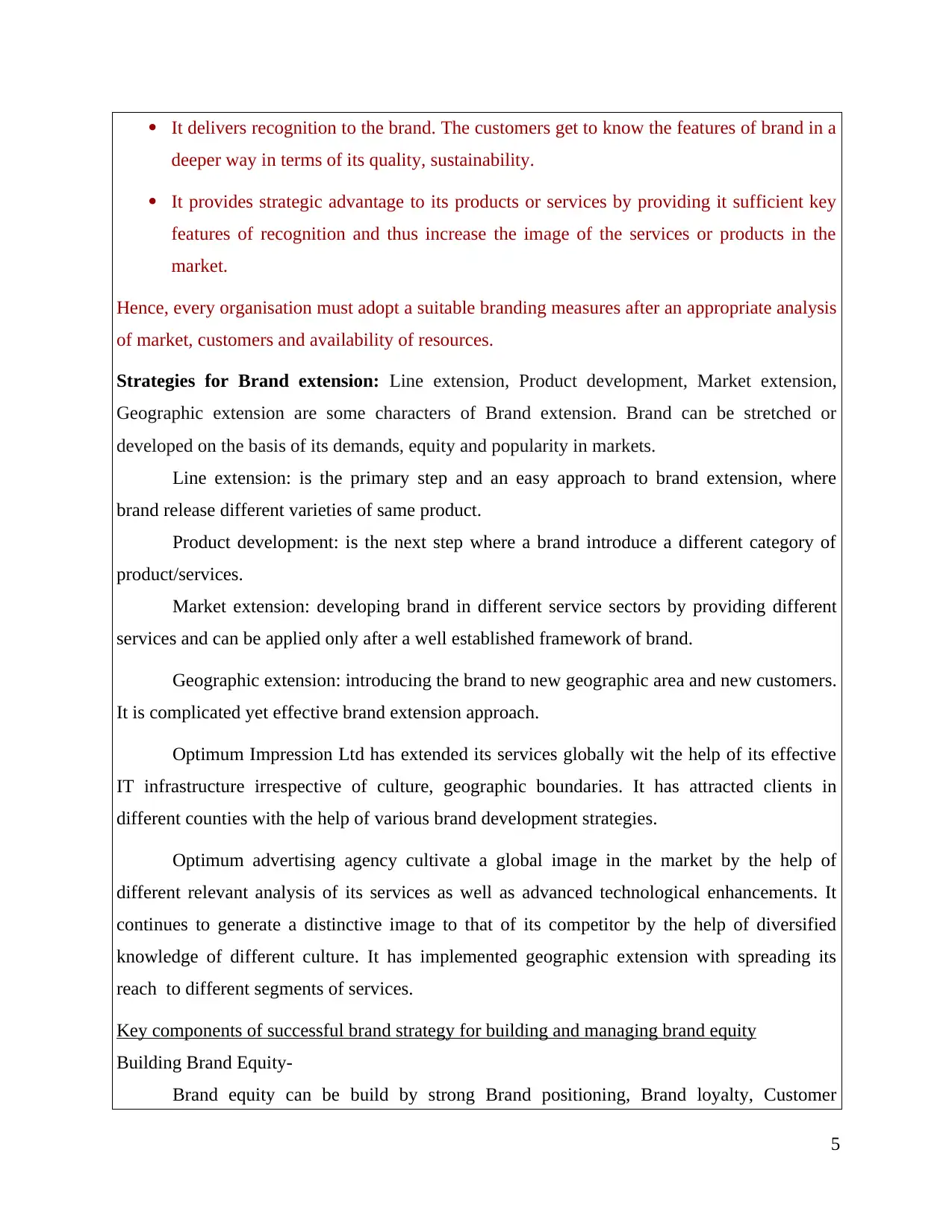
It delivers recognition to the brand. The customers get to know the features of brand in a
deeper way in terms of its quality, sustainability.
It provides strategic advantage to its products or services by providing it sufficient key
features of recognition and thus increase the image of the services or products in the
market.
Hence, every organisation must adopt a suitable branding measures after an appropriate analysis
of market, customers and availability of resources.
Strategies for Brand extension: Line extension, Product development, Market extension,
Geographic extension are some characters of Brand extension. Brand can be stretched or
developed on the basis of its demands, equity and popularity in markets.
Line extension: is the primary step and an easy approach to brand extension, where
brand release different varieties of same product.
Product development: is the next step where a brand introduce a different category of
product/services.
Market extension: developing brand in different service sectors by providing different
services and can be applied only after a well established framework of brand.
Geographic extension: introducing the brand to new geographic area and new customers.
It is complicated yet effective brand extension approach.
Optimum Impression Ltd has extended its services globally wit the help of its effective
IT infrastructure irrespective of culture, geographic boundaries. It has attracted clients in
different counties with the help of various brand development strategies.
Optimum advertising agency cultivate a global image in the market by the help of
different relevant analysis of its services as well as advanced technological enhancements. It
continues to generate a distinctive image to that of its competitor by the help of diversified
knowledge of different culture. It has implemented geographic extension with spreading its
reach to different segments of services.
Key components of successful brand strategy for building and managing brand equity
Building Brand Equity-
Brand equity can be build by strong Brand positioning, Brand loyalty, Customer
5
deeper way in terms of its quality, sustainability.
It provides strategic advantage to its products or services by providing it sufficient key
features of recognition and thus increase the image of the services or products in the
market.
Hence, every organisation must adopt a suitable branding measures after an appropriate analysis
of market, customers and availability of resources.
Strategies for Brand extension: Line extension, Product development, Market extension,
Geographic extension are some characters of Brand extension. Brand can be stretched or
developed on the basis of its demands, equity and popularity in markets.
Line extension: is the primary step and an easy approach to brand extension, where
brand release different varieties of same product.
Product development: is the next step where a brand introduce a different category of
product/services.
Market extension: developing brand in different service sectors by providing different
services and can be applied only after a well established framework of brand.
Geographic extension: introducing the brand to new geographic area and new customers.
It is complicated yet effective brand extension approach.
Optimum Impression Ltd has extended its services globally wit the help of its effective
IT infrastructure irrespective of culture, geographic boundaries. It has attracted clients in
different counties with the help of various brand development strategies.
Optimum advertising agency cultivate a global image in the market by the help of
different relevant analysis of its services as well as advanced technological enhancements. It
continues to generate a distinctive image to that of its competitor by the help of diversified
knowledge of different culture. It has implemented geographic extension with spreading its
reach to different segments of services.
Key components of successful brand strategy for building and managing brand equity
Building Brand Equity-
Brand equity can be build by strong Brand positioning, Brand loyalty, Customer
5
Paraphrase This Document
Need a fresh take? Get an instant paraphrase of this document with our AI Paraphraser
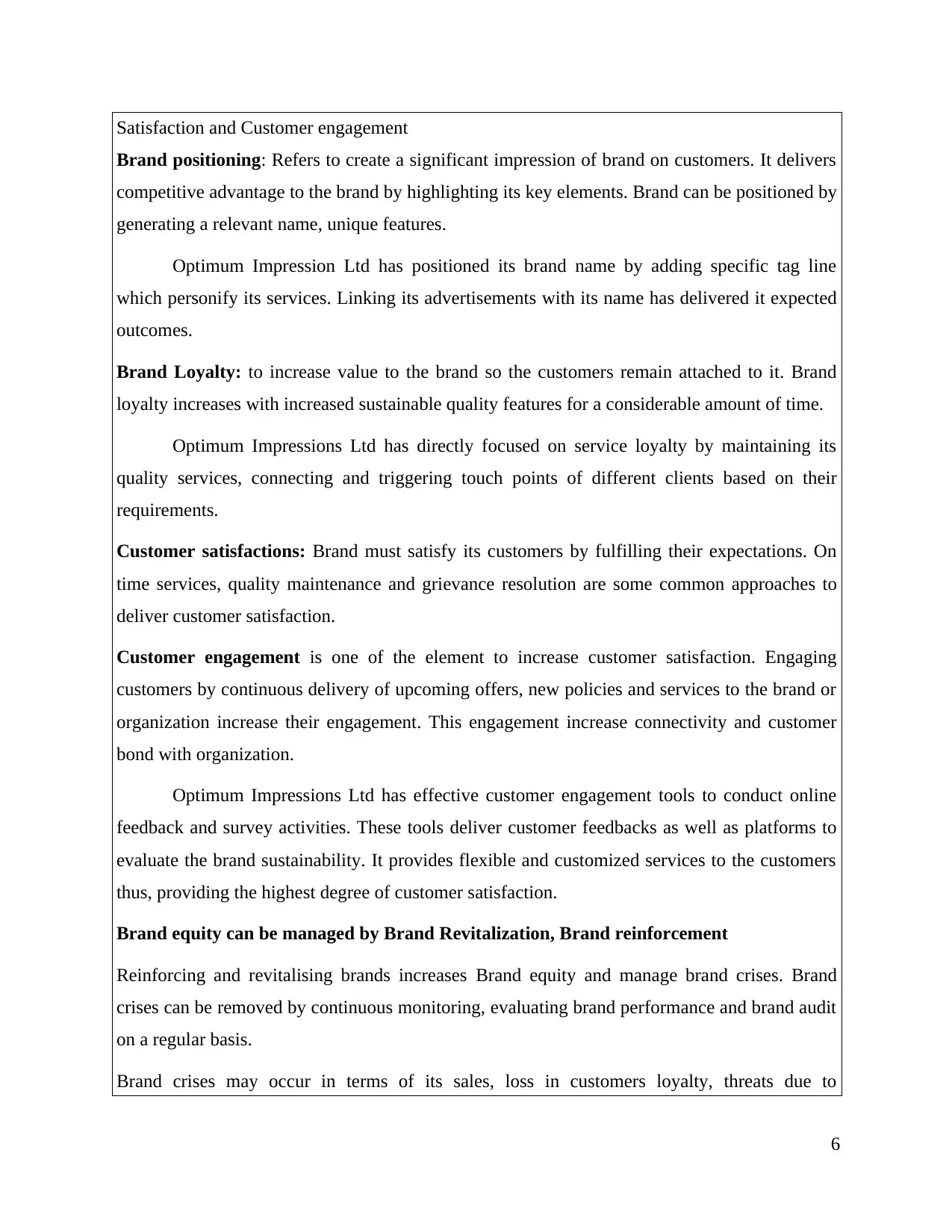
Satisfaction and Customer engagement
Brand positioning: Refers to create a significant impression of brand on customers. It delivers
competitive advantage to the brand by highlighting its key elements. Brand can be positioned by
generating a relevant name, unique features.
Optimum Impression Ltd has positioned its brand name by adding specific tag line
which personify its services. Linking its advertisements with its name has delivered it expected
outcomes.
Brand Loyalty: to increase value to the brand so the customers remain attached to it. Brand
loyalty increases with increased sustainable quality features for a considerable amount of time.
Optimum Impressions Ltd has directly focused on service loyalty by maintaining its
quality services, connecting and triggering touch points of different clients based on their
requirements.
Customer satisfactions: Brand must satisfy its customers by fulfilling their expectations. On
time services, quality maintenance and grievance resolution are some common approaches to
deliver customer satisfaction.
Customer engagement is one of the element to increase customer satisfaction. Engaging
customers by continuous delivery of upcoming offers, new policies and services to the brand or
organization increase their engagement. This engagement increase connectivity and customer
bond with organization.
Optimum Impressions Ltd has effective customer engagement tools to conduct online
feedback and survey activities. These tools deliver customer feedbacks as well as platforms to
evaluate the brand sustainability. It provides flexible and customized services to the customers
thus, providing the highest degree of customer satisfaction.
Brand equity can be managed by Brand Revitalization, Brand reinforcement
Reinforcing and revitalising brands increases Brand equity and manage brand crises. Brand
crises can be removed by continuous monitoring, evaluating brand performance and brand audit
on a regular basis.
Brand crises may occur in terms of its sales, loss in customers loyalty, threats due to
6
Brand positioning: Refers to create a significant impression of brand on customers. It delivers
competitive advantage to the brand by highlighting its key elements. Brand can be positioned by
generating a relevant name, unique features.
Optimum Impression Ltd has positioned its brand name by adding specific tag line
which personify its services. Linking its advertisements with its name has delivered it expected
outcomes.
Brand Loyalty: to increase value to the brand so the customers remain attached to it. Brand
loyalty increases with increased sustainable quality features for a considerable amount of time.
Optimum Impressions Ltd has directly focused on service loyalty by maintaining its
quality services, connecting and triggering touch points of different clients based on their
requirements.
Customer satisfactions: Brand must satisfy its customers by fulfilling their expectations. On
time services, quality maintenance and grievance resolution are some common approaches to
deliver customer satisfaction.
Customer engagement is one of the element to increase customer satisfaction. Engaging
customers by continuous delivery of upcoming offers, new policies and services to the brand or
organization increase their engagement. This engagement increase connectivity and customer
bond with organization.
Optimum Impressions Ltd has effective customer engagement tools to conduct online
feedback and survey activities. These tools deliver customer feedbacks as well as platforms to
evaluate the brand sustainability. It provides flexible and customized services to the customers
thus, providing the highest degree of customer satisfaction.
Brand equity can be managed by Brand Revitalization, Brand reinforcement
Reinforcing and revitalising brands increases Brand equity and manage brand crises. Brand
crises can be removed by continuous monitoring, evaluating brand performance and brand audit
on a regular basis.
Brand crises may occur in terms of its sales, loss in customers loyalty, threats due to
6
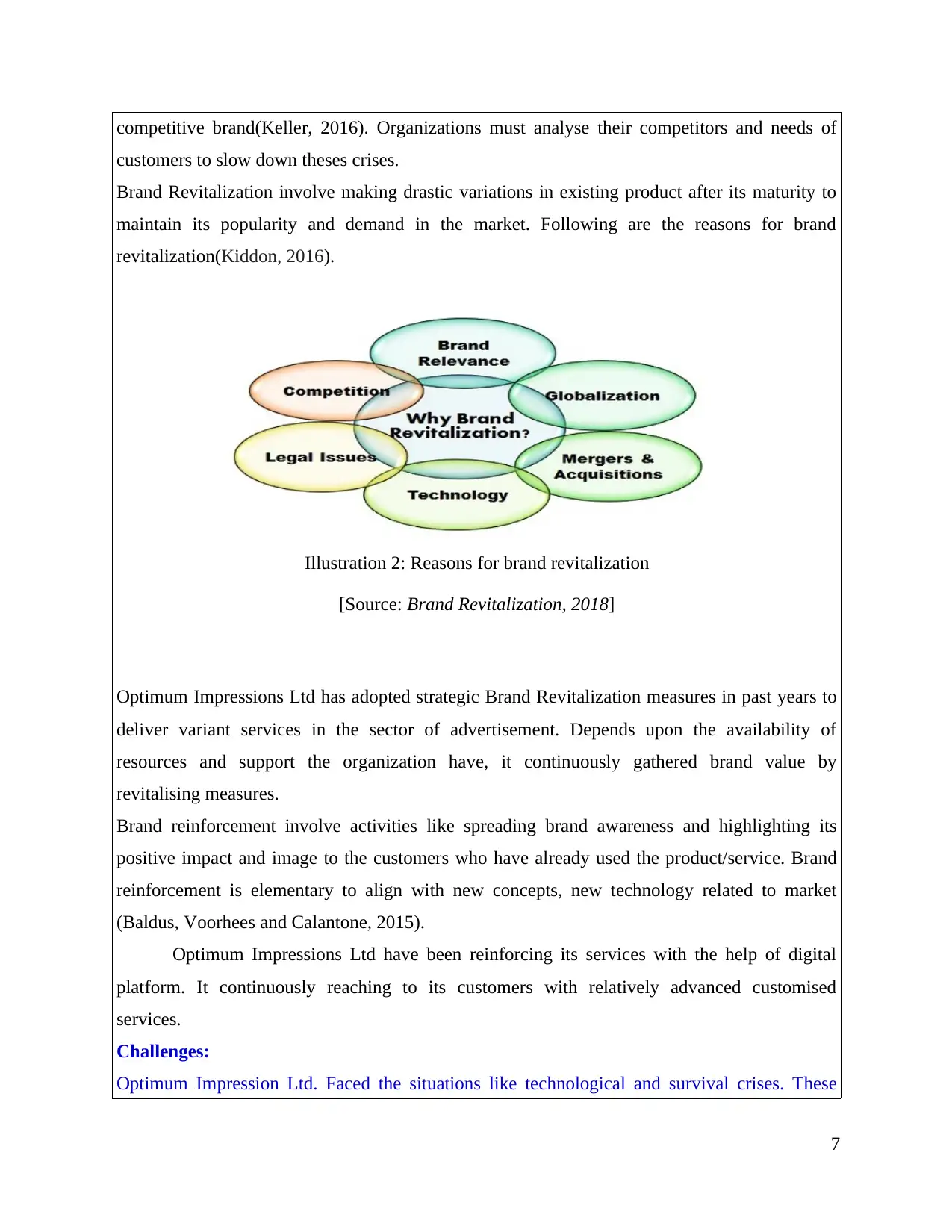
competitive brand(Keller, 2016). Organizations must analyse their competitors and needs of
customers to slow down theses crises.
Brand Revitalization involve making drastic variations in existing product after its maturity to
maintain its popularity and demand in the market. Following are the reasons for brand
revitalization(Kiddon, 2016).
Optimum Impressions Ltd has adopted strategic Brand Revitalization measures in past years to
deliver variant services in the sector of advertisement. Depends upon the availability of
resources and support the organization have, it continuously gathered brand value by
revitalising measures.
Brand reinforcement involve activities like spreading brand awareness and highlighting its
positive impact and image to the customers who have already used the product/service. Brand
reinforcement is elementary to align with new concepts, new technology related to market
(Baldus, Voorhees and Calantone, 2015).
Optimum Impressions Ltd have been reinforcing its services with the help of digital
platform. It continuously reaching to its customers with relatively advanced customised
services.
Challenges:
Optimum Impression Ltd. Faced the situations like technological and survival crises. These
7
Illustration 2: Reasons for brand revitalization
[Source: Brand Revitalization, 2018]
customers to slow down theses crises.
Brand Revitalization involve making drastic variations in existing product after its maturity to
maintain its popularity and demand in the market. Following are the reasons for brand
revitalization(Kiddon, 2016).
Optimum Impressions Ltd has adopted strategic Brand Revitalization measures in past years to
deliver variant services in the sector of advertisement. Depends upon the availability of
resources and support the organization have, it continuously gathered brand value by
revitalising measures.
Brand reinforcement involve activities like spreading brand awareness and highlighting its
positive impact and image to the customers who have already used the product/service. Brand
reinforcement is elementary to align with new concepts, new technology related to market
(Baldus, Voorhees and Calantone, 2015).
Optimum Impressions Ltd have been reinforcing its services with the help of digital
platform. It continuously reaching to its customers with relatively advanced customised
services.
Challenges:
Optimum Impression Ltd. Faced the situations like technological and survival crises. These
7
Illustration 2: Reasons for brand revitalization
[Source: Brand Revitalization, 2018]
⊘ This is a preview!⊘
Do you want full access?
Subscribe today to unlock all pages.

Trusted by 1+ million students worldwide
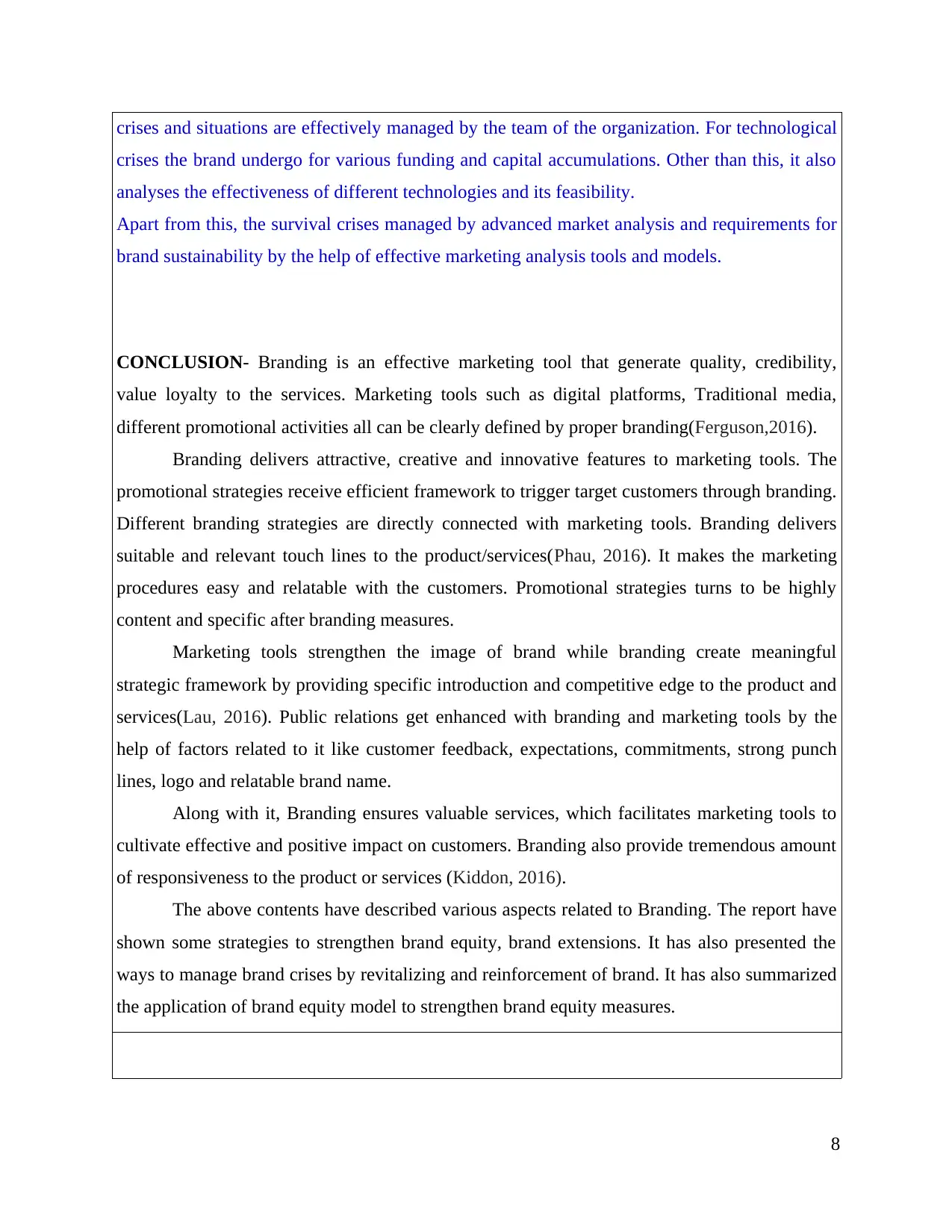
crises and situations are effectively managed by the team of the organization. For technological
crises the brand undergo for various funding and capital accumulations. Other than this, it also
analyses the effectiveness of different technologies and its feasibility.
Apart from this, the survival crises managed by advanced market analysis and requirements for
brand sustainability by the help of effective marketing analysis tools and models.
CONCLUSION- Branding is an effective marketing tool that generate quality, credibility,
value loyalty to the services. Marketing tools such as digital platforms, Traditional media,
different promotional activities all can be clearly defined by proper branding(Ferguson,2016).
Branding delivers attractive, creative and innovative features to marketing tools. The
promotional strategies receive efficient framework to trigger target customers through branding.
Different branding strategies are directly connected with marketing tools. Branding delivers
suitable and relevant touch lines to the product/services(Phau, 2016). It makes the marketing
procedures easy and relatable with the customers. Promotional strategies turns to be highly
content and specific after branding measures.
Marketing tools strengthen the image of brand while branding create meaningful
strategic framework by providing specific introduction and competitive edge to the product and
services(Lau, 2016). Public relations get enhanced with branding and marketing tools by the
help of factors related to it like customer feedback, expectations, commitments, strong punch
lines, logo and relatable brand name.
Along with it, Branding ensures valuable services, which facilitates marketing tools to
cultivate effective and positive impact on customers. Branding also provide tremendous amount
of responsiveness to the product or services (Kiddon, 2016).
The above contents have described various aspects related to Branding. The report have
shown some strategies to strengthen brand equity, brand extensions. It has also presented the
ways to manage brand crises by revitalizing and reinforcement of brand. It has also summarized
the application of brand equity model to strengthen brand equity measures.
8
crises the brand undergo for various funding and capital accumulations. Other than this, it also
analyses the effectiveness of different technologies and its feasibility.
Apart from this, the survival crises managed by advanced market analysis and requirements for
brand sustainability by the help of effective marketing analysis tools and models.
CONCLUSION- Branding is an effective marketing tool that generate quality, credibility,
value loyalty to the services. Marketing tools such as digital platforms, Traditional media,
different promotional activities all can be clearly defined by proper branding(Ferguson,2016).
Branding delivers attractive, creative and innovative features to marketing tools. The
promotional strategies receive efficient framework to trigger target customers through branding.
Different branding strategies are directly connected with marketing tools. Branding delivers
suitable and relevant touch lines to the product/services(Phau, 2016). It makes the marketing
procedures easy and relatable with the customers. Promotional strategies turns to be highly
content and specific after branding measures.
Marketing tools strengthen the image of brand while branding create meaningful
strategic framework by providing specific introduction and competitive edge to the product and
services(Lau, 2016). Public relations get enhanced with branding and marketing tools by the
help of factors related to it like customer feedback, expectations, commitments, strong punch
lines, logo and relatable brand name.
Along with it, Branding ensures valuable services, which facilitates marketing tools to
cultivate effective and positive impact on customers. Branding also provide tremendous amount
of responsiveness to the product or services (Kiddon, 2016).
The above contents have described various aspects related to Branding. The report have
shown some strategies to strengthen brand equity, brand extensions. It has also presented the
ways to manage brand crises by revitalizing and reinforcement of brand. It has also summarized
the application of brand equity model to strengthen brand equity measures.
8
Paraphrase This Document
Need a fresh take? Get an instant paraphrase of this document with our AI Paraphraser
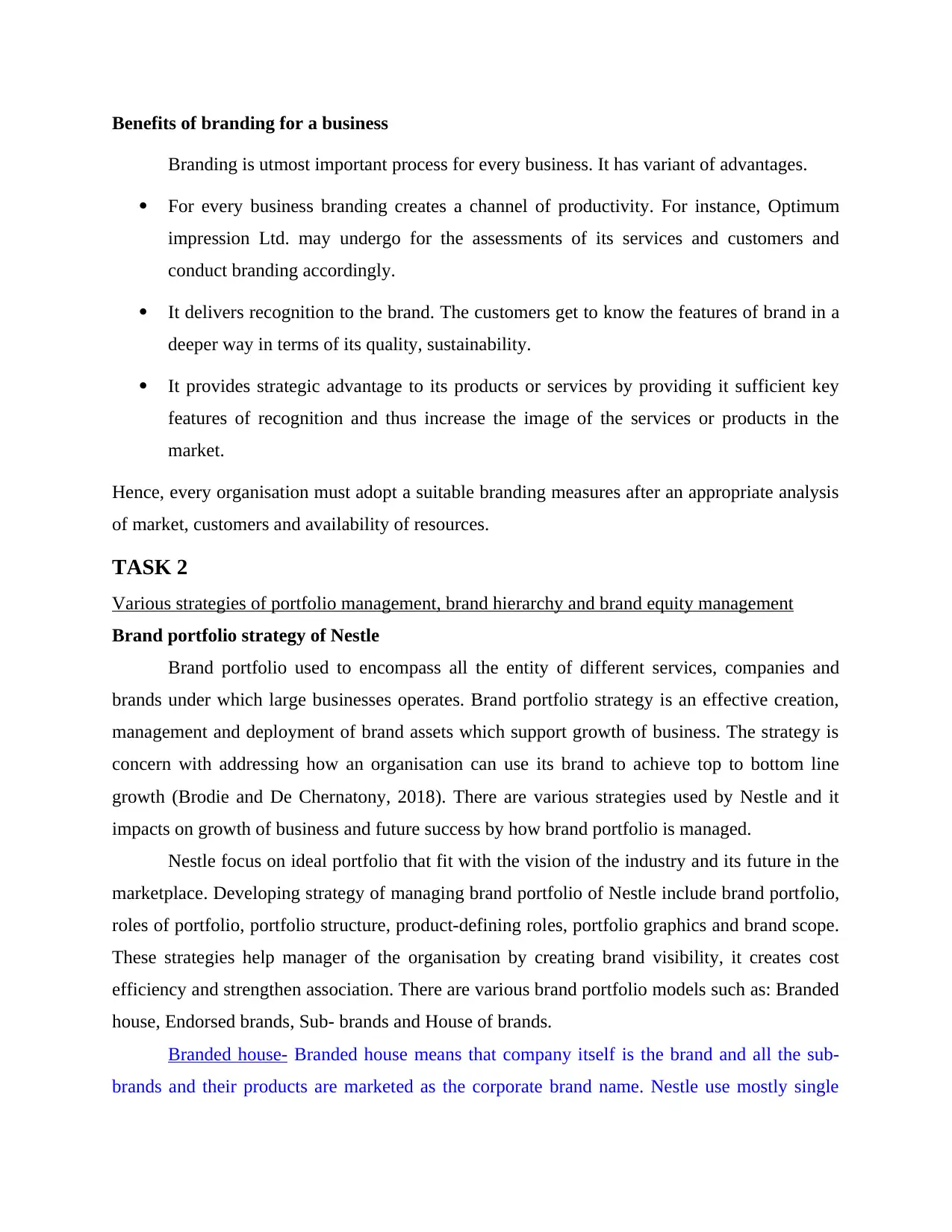
Benefits of branding for a business
Branding is utmost important process for every business. It has variant of advantages.
For every business branding creates a channel of productivity. For instance, Optimum
impression Ltd. may undergo for the assessments of its services and customers and
conduct branding accordingly.
It delivers recognition to the brand. The customers get to know the features of brand in a
deeper way in terms of its quality, sustainability.
It provides strategic advantage to its products or services by providing it sufficient key
features of recognition and thus increase the image of the services or products in the
market.
Hence, every organisation must adopt a suitable branding measures after an appropriate analysis
of market, customers and availability of resources.
TASK 2
Various strategies of portfolio management, brand hierarchy and brand equity management
Brand portfolio strategy of Nestle
Brand portfolio used to encompass all the entity of different services, companies and
brands under which large businesses operates. Brand portfolio strategy is an effective creation,
management and deployment of brand assets which support growth of business. The strategy is
concern with addressing how an organisation can use its brand to achieve top to bottom line
growth (Brodie and De Chernatony, 2018). There are various strategies used by Nestle and it
impacts on growth of business and future success by how brand portfolio is managed.
Nestle focus on ideal portfolio that fit with the vision of the industry and its future in the
marketplace. Developing strategy of managing brand portfolio of Nestle include brand portfolio,
roles of portfolio, portfolio structure, product-defining roles, portfolio graphics and brand scope.
These strategies help manager of the organisation by creating brand visibility, it creates cost
efficiency and strengthen association. There are various brand portfolio models such as: Branded
house, Endorsed brands, Sub- brands and House of brands.
Branded house- Branded house means that company itself is the brand and all the sub-
brands and their products are marketed as the corporate brand name. Nestle use mostly single
Branding is utmost important process for every business. It has variant of advantages.
For every business branding creates a channel of productivity. For instance, Optimum
impression Ltd. may undergo for the assessments of its services and customers and
conduct branding accordingly.
It delivers recognition to the brand. The customers get to know the features of brand in a
deeper way in terms of its quality, sustainability.
It provides strategic advantage to its products or services by providing it sufficient key
features of recognition and thus increase the image of the services or products in the
market.
Hence, every organisation must adopt a suitable branding measures after an appropriate analysis
of market, customers and availability of resources.
TASK 2
Various strategies of portfolio management, brand hierarchy and brand equity management
Brand portfolio strategy of Nestle
Brand portfolio used to encompass all the entity of different services, companies and
brands under which large businesses operates. Brand portfolio strategy is an effective creation,
management and deployment of brand assets which support growth of business. The strategy is
concern with addressing how an organisation can use its brand to achieve top to bottom line
growth (Brodie and De Chernatony, 2018). There are various strategies used by Nestle and it
impacts on growth of business and future success by how brand portfolio is managed.
Nestle focus on ideal portfolio that fit with the vision of the industry and its future in the
marketplace. Developing strategy of managing brand portfolio of Nestle include brand portfolio,
roles of portfolio, portfolio structure, product-defining roles, portfolio graphics and brand scope.
These strategies help manager of the organisation by creating brand visibility, it creates cost
efficiency and strengthen association. There are various brand portfolio models such as: Branded
house, Endorsed brands, Sub- brands and House of brands.
Branded house- Branded house means that company itself is the brand and all the sub-
brands and their products are marketed as the corporate brand name. Nestle use mostly single
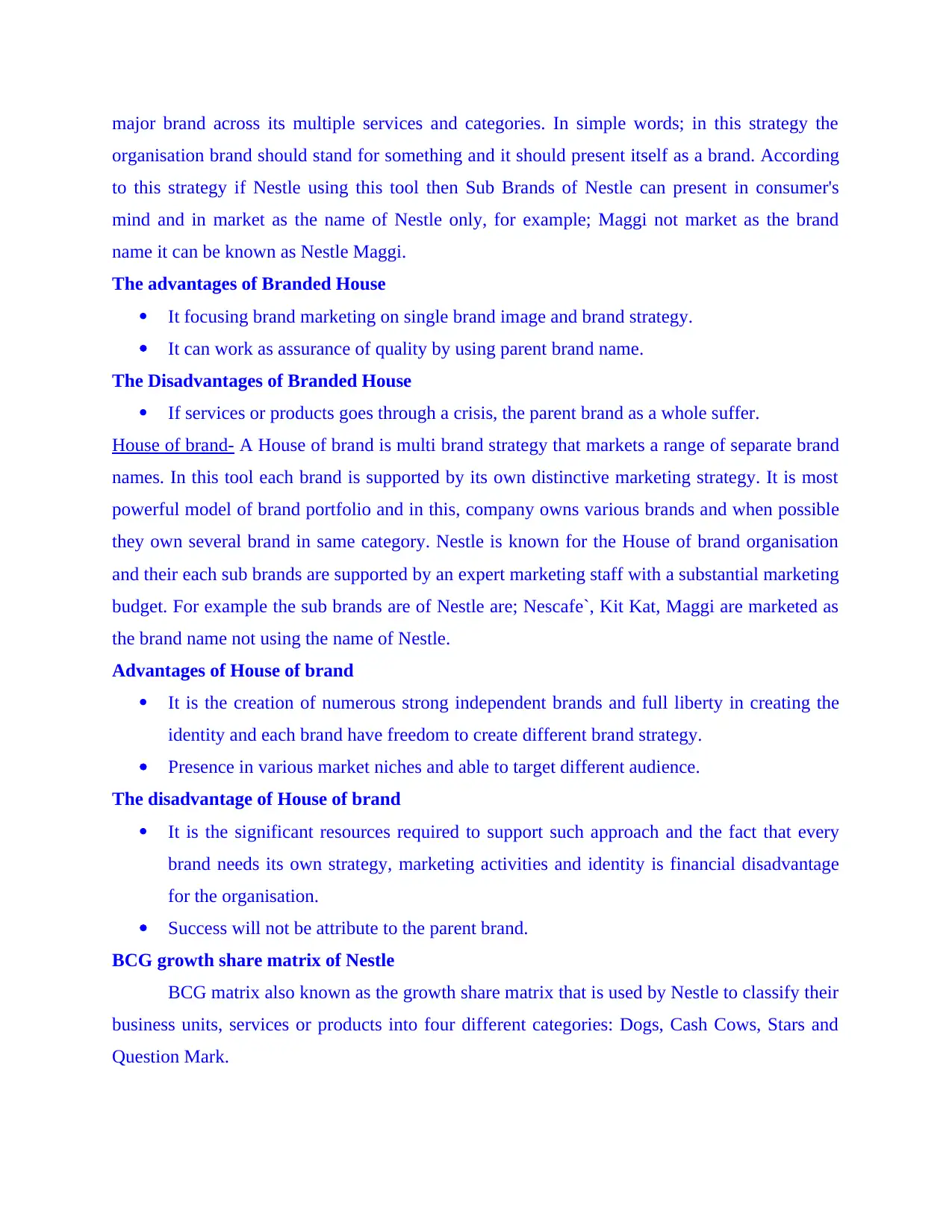
major brand across its multiple services and categories. In simple words; in this strategy the
organisation brand should stand for something and it should present itself as a brand. According
to this strategy if Nestle using this tool then Sub Brands of Nestle can present in consumer's
mind and in market as the name of Nestle only, for example; Maggi not market as the brand
name it can be known as Nestle Maggi.
The advantages of Branded House
It focusing brand marketing on single brand image and brand strategy.
It can work as assurance of quality by using parent brand name.
The Disadvantages of Branded House
If services or products goes through a crisis, the parent brand as a whole suffer.
House of brand- A House of brand is multi brand strategy that markets a range of separate brand
names. In this tool each brand is supported by its own distinctive marketing strategy. It is most
powerful model of brand portfolio and in this, company owns various brands and when possible
they own several brand in same category. Nestle is known for the House of brand organisation
and their each sub brands are supported by an expert marketing staff with a substantial marketing
budget. For example the sub brands are of Nestle are; Nescafe`, Kit Kat, Maggi are marketed as
the brand name not using the name of Nestle.
Advantages of House of brand
It is the creation of numerous strong independent brands and full liberty in creating the
identity and each brand have freedom to create different brand strategy.
Presence in various market niches and able to target different audience.
The disadvantage of House of brand
It is the significant resources required to support such approach and the fact that every
brand needs its own strategy, marketing activities and identity is financial disadvantage
for the organisation.
Success will not be attribute to the parent brand.
BCG growth share matrix of Nestle
BCG matrix also known as the growth share matrix that is used by Nestle to classify their
business units, services or products into four different categories: Dogs, Cash Cows, Stars and
Question Mark.
organisation brand should stand for something and it should present itself as a brand. According
to this strategy if Nestle using this tool then Sub Brands of Nestle can present in consumer's
mind and in market as the name of Nestle only, for example; Maggi not market as the brand
name it can be known as Nestle Maggi.
The advantages of Branded House
It focusing brand marketing on single brand image and brand strategy.
It can work as assurance of quality by using parent brand name.
The Disadvantages of Branded House
If services or products goes through a crisis, the parent brand as a whole suffer.
House of brand- A House of brand is multi brand strategy that markets a range of separate brand
names. In this tool each brand is supported by its own distinctive marketing strategy. It is most
powerful model of brand portfolio and in this, company owns various brands and when possible
they own several brand in same category. Nestle is known for the House of brand organisation
and their each sub brands are supported by an expert marketing staff with a substantial marketing
budget. For example the sub brands are of Nestle are; Nescafe`, Kit Kat, Maggi are marketed as
the brand name not using the name of Nestle.
Advantages of House of brand
It is the creation of numerous strong independent brands and full liberty in creating the
identity and each brand have freedom to create different brand strategy.
Presence in various market niches and able to target different audience.
The disadvantage of House of brand
It is the significant resources required to support such approach and the fact that every
brand needs its own strategy, marketing activities and identity is financial disadvantage
for the organisation.
Success will not be attribute to the parent brand.
BCG growth share matrix of Nestle
BCG matrix also known as the growth share matrix that is used by Nestle to classify their
business units, services or products into four different categories: Dogs, Cash Cows, Stars and
Question Mark.
⊘ This is a preview!⊘
Do you want full access?
Subscribe today to unlock all pages.

Trusted by 1+ million students worldwide
1 out of 24
Related Documents
Your All-in-One AI-Powered Toolkit for Academic Success.
+13062052269
info@desklib.com
Available 24*7 on WhatsApp / Email
![[object Object]](/_next/static/media/star-bottom.7253800d.svg)
Unlock your academic potential
Copyright © 2020–2025 A2Z Services. All Rights Reserved. Developed and managed by ZUCOL.




